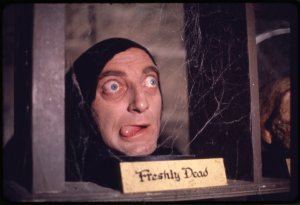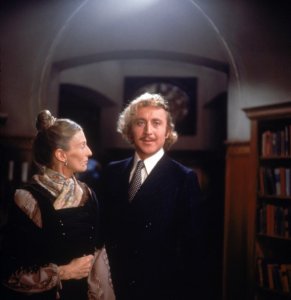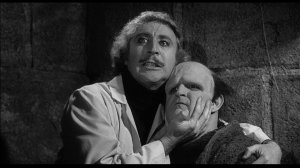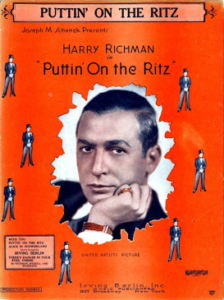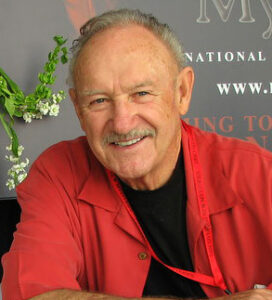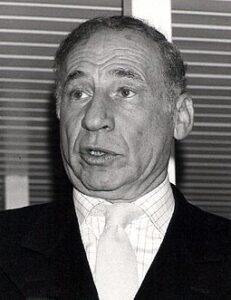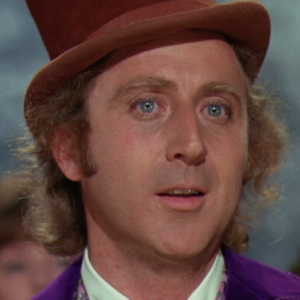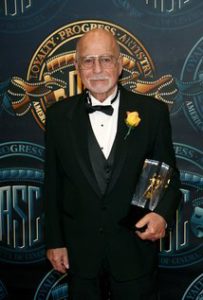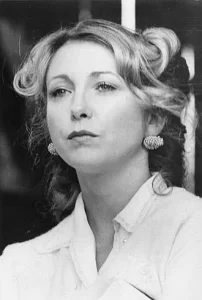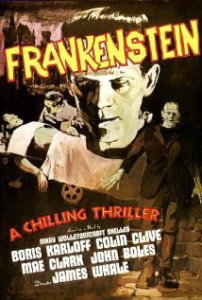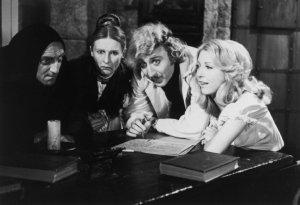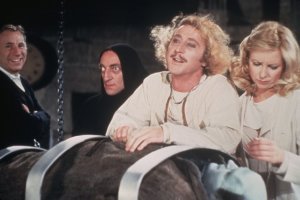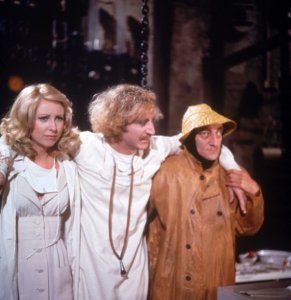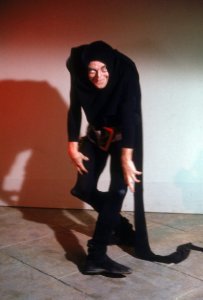Young Frankenstein ***** (1974, Gene Wilder, Peter Boyle, Marty Feldman, Cloris Leachman, Teri Garr, Madeline Kahn, Kenneth Mars, Richard Haydn, Gene Hackman) – Classic Movie Review 1,939
Mel Brooks’s deservedly much-loved 1974 horror comedy film masterpiece Young Frankenstein mixes homage and spoof to perfection. Gene Wilder, Peter Boyle and Marty Feldman are beyond brilliant.
Director Mel Brooks’s deservedly much-loved horror comedy masterpiece Young Frankenstein is made in his annus mirabilis, 1974, released the same year as his other masterwork Blazing Saddles. It was dreamt up when Brooks and Gene Wilder were having a cup of coffee while shooting the last few weeks of Blazing Saddles.
Brooks recalled: ‘He said, I have this idea that there could be another Frankenstein. I said, “Not another! We’ve had the son of, the cousin of, the brother-in-law. We don’t need another Frankenstein.” His idea was very simple: What if the grandson of Dr Frankenstein wanted nothing to do with the family whatsoever. He was ashamed of those wackos. I said, “That’s funny.”
‘Gene and I then met every night at his bungalow at the Bel Air Hotel. We ordered a pot of Earl Grey tea, cream, brown sugar cubes and a pack of British digestive biscuits. And step-by-step, ever so cautiously, we proceeded on a dark narrow twisting path to the eventual screenplay in which good sense and caution are thrown out of the window and madness ensues.’
Both as director and co-writer of the story and screenplay with its star Gene Wilder, Brooks is on his most inspired, inventive and dynamic form. Brooks clearly enjoys delivering a monster fun time with Wilder’s mad scientist Dr Frankenstein (it’s alive!’), Peter Boyle as The Monster (sort of) singing and dancing ‘Puttin’ on the Ritz’, Gene Hackman’s memorably clumsy blind man, Cloris Leachman hysterical as the crazy old housekeeper Frau Blücher, and Marty Feldman as the hilariously funny hunchback Igor (‘yes master’).
Wilder’s young neurosurgeon Dr Frederick Frankenstein inherits his infamous grandfather Dr Victor von Frankenstein’s castle, where he meets Igor, Inga (Teri Garr) and Blücher. At first Dr Frankenstein dismisses his grandfather’s life’s work but he changes his mind when he discovers his grandfather’s book describing his reanimation experiments. And soon he’s ‘Puttin’ on the Ritz’ with The Monster he’s created, singing and dancing in a stage double act to bring the house down.
Frederick gets over-interested in the nubile Inga, which causes complications when his dotty fiancée Elizabeth (Madeline Kahn) turns up unexpectedly. But luckily Elizabeth gets interested in the over-sized charms of The Monster. Carry on-style comedy ensues. Suddenly, good taste, as well as darts, fly out of the window.
Brooks turns in a warmly affectionate, hilarious toast to the old Frankenstein films. It mixes homage and spoof to perfection, pushing both elements just about as far as they could go, which is the only way to go here. The film’s got chutzpah. It is shot in gleaming black and white in an incredibly striking visual triumph, thanks to Gerald Hirschfeld’s glorious cinematography, with perfectly attuned sets by production designer Dale Hennesy and music by John Morris, plus, wonder of wonders, the Universal studio’s original Thirties lab equipment from its classic 1931 Frankenstein film. Every frame of the film is a beautiful work of art.
Also adding much to the fun are the Thirties-style Gothic opening credits and the vintage-style scene transition devices such as iris outs, wipes, and fades to black. It’s inspired!
Madeline Kahn (as Wilder’s dotty fiancée Elizabeth), Kenneth Mars (as Inspector Kemp), Richard Haydn (as Herr Falkstein), Teri Garr (as the cute, sexy, pretty lab assistant Inga), Arthur Malet (Village Elder), Liam Dunn, Danny Goldman and Oscar Beregi also join in the glorious fun. All these wonderful performers are on their most brilliant form.
Performance-wise though, it is Wilder’s movie, with almost all the focus and attention on him, and he’s brilliant, comically crazed and demented to the max. It’s such an alive performance, both attractive and creepy, dynamic and magnetic, moving instantly from just a single eye movement with his face in close-up to hysterical manic bursts of rage and action. But it is also Feldman’s movie, a tour-de-force of comedic performing genius, using his whole body, not just his famous eyes, to be hilarious. Wilder wrote the role for Feldman, who added swapping the side his hump was located (‘What hump?’).
And then, who? Yes, Boyle is brilliant as the Monster, just wonderful, both menacing and moving in the Karloff tradition, and Kenneth Mars is absolutely outrageous as physically challenged (and probably mentally challenged) Inspector Kemp, starting over the top and working up from there, but somehow holding onto it, and keeping it continually funny.
Young Frankenstein is one heck of a perfect, adorable movie, arguably Brooks’s best. All the jokes work, because they cut out all the unfunny ones from the original cut, which was twice as long. In 2014, its 40th anniversary, Brooks called it by far his finest – though not his funniest – film. Well, he’s not in it, is he?
Wilder insisted that Brooks should not appear in the film. He said, ‘If you’re not in it, I’ll do it.’ But Brooks provides the voices of the Werewolf, Dr Victor von Frankenstein and the Cat Hit by Dart (the idea of the dart hitting a cat was ad-libbed so when Wilder threw his dart off camera, Brooks screamed like a cat). Brooks later tried to revisit the horror spoof territory with the 1995 Dracula Dead and Loving It, but the magic isn’t there that time.
Brooks discovered that Ken Strickfaden, who made the elaborate electrical machinery for the lab sequences in the Universal Frankenstein films, had kept it safely stored in his LA garage. Brooks hired it and gave him the screen credit that he didn’t get for the original films.
Shooting on Blazing Saddles took place from March 6, 1973 to early May 1973, and it was released on February 7, 1974. Young Frankenstein was shot from February 19, 1974 to May 3, 1974, and it was released on December 15, 1974.
Columbia Pictures turned Young Frankenstein down as too costly, but 20th Century-Fox agreed. It grossed $86.2 million on a $2.78 million budget.
Irving Berlin’s 1929 song ‘Puttin’ On the Ritz’ renewed its popularity in 1974 when it was performed by Wilder and Boyle in Young Frankenstein. Brooks and Wilder argued over the sequence. Brooks felt it was too silly to have the monster sing and dance, but eventually yielded to Wilder’s arguments. Wilder and Boyle’s version of the song was ranked 84th in the American Film Institute’s 2004 list, 100 Years…100 Songs. It was introduced by Harry Richman and chorus in the 1930 musical film Puttin’ On the Ritz.
You might be wondering what the heck Gene Hackman is doing in Young Frankenstein. Well, a clue might be that Gene Wilder played Eugene Grizzard in his 1967 film debut Bonnie and Clyde, featuring Gene Hackman. Gene is a great screen actor but not naturally a funny man. But, to be fair, he’s really quite a hoot as the Blind Man.
Eugene Allen Hackman (January 30, 1930 – February 26, 2025)
Mel Brooks
Mel Brooks (born Melvin James Kaminsky on June 28, 1926) is one of 18 entertainers to win the EGOT (Emmy Award, Grammy, Oscar and a Tony).
Lovely funny man Gene Wilder, star of Blazing Saddles, Young Frankenstein, Willy Wonka and the Chocolate Factory, Silver Streak and The Producers, died on aged 83. Mel Brooks said he was: ‘One of the truly great talents of our time. He blessed every film we did with his magic and he blessed me with his friendship.’
Gerald Hirschfeld, the veteran cinematographer who shot the films Fail Safe and Young Frankenstein in beautiful black and white, died on 13 February 2017 of natural causes at his home in Ashland, Oregon, aged 95.
Teri Garr (born Terry Ann Garr (December 11, 1944 – October 29, 2024)
Teri Garr died from complications of multiple sclerosis at her home in Los Angeles on 29 October 2024, aged 79.
Garr came to prominence in Francis Ford Coppola’s The Conversation (1974), Mel Brooks’s Young Frankenstein (1974), and Steven Spielberg’s Close Encounters of the Third Kind (1977). She gained an Academy Award nomination for Best Supporting Actress in Tootsie (1982). She reunited with Coppola for One from the Heart (1982), starred in Mr Mom (1983) and acted in Martin Scorsese’s After Hours (1985).
http://derekwinnert.com/frankenstein-classic-film-review/
http://derekwinnert.com/blazing-saddles-classic-film-review-215/
© Derek Winnert 2014 Classic Movie Review 1,939
Check out more reviews on http://derekwinnert.com/


